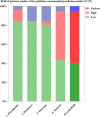Recommendations for prediction models in clinical practice guidelines for cardiovascular diseases are over-optimistic: a global survey utilizing a systematic literature search
- PMID: 39484015
- PMCID: PMC11524858
- DOI: 10.3389/fcvm.2024.1449058
Recommendations for prediction models in clinical practice guidelines for cardiovascular diseases are over-optimistic: a global survey utilizing a systematic literature search
Abstract
Background: This study aimed to synthesize the recommendations for prediction models in cardiovascular clinical practice guidelines (CPGs) and assess the methodological quality of the relevant primary modeling studies.
Methods: We performed a systematic literature search of all available cardiovascular CPGs published between 2018 and 2023 that presented specific recommendations (whether in support or non-support) for at least one multivariable clinical prediction model. For the guideline-recommended models, the assessment of the methodological quality of their primary modeling studies was conducted using the Prediction model Risk Of Bias ASsessment Tool (PROBAST).
Results: In total, 46 qualified cardiovascular CPGs were included, with 69 prediction models and 80 specific recommendations. Of the 80 specific recommendations, 74 supported 57 models (53 were fully recommended and 4 were conditionally recommended) in cardiovascular practice with moderate to strong strength. Most of the guideline-recommended models were focused on predicting prognosis outcomes (53/57, 93%) in primary and tertiary prevention, focusing primarily on long-term risk stratification and prognosis management. A total of 10 conditions and 7 types of target population were involved in the 57 models, while heart failure (14/57, 25%) and a general population with or without cardiovascular risk factor(s) (12/57, 21%) received the most attention from the guidelines. The assessment of the methodological quality of 57 primary studies on the development of the guideline-recommended models revealed that only 40% of the modeling studies had a low risk of bias (ROB). The causes of high ROB were mainly in the analysis and participant domains.
Conclusions: Global cardiovascular CPGs presented an unduly positive appraisal of the existing prediction models in terms of ROB, leading to stronger recommendations than were warranted. Future cardiovascular practice may benefit from well-established clinical prediction models with better methodological quality and extensive external validation.
Keywords: cardiovascular diseases; clinical practice guideline; methodological quality; prediction model; recommendation; risk of bias.
© 2024 Jing, Zhang, Feng, Li, Liang, Hu and Liao.
Conflict of interest statement
XL reported receiving grants from National Natural Science Foundation of China, China Academy of Chinese Medical Sciences, and China Center for Evidence Based Traditional Chinese Medicine. The remaining authors declare that the research was conducted in the absence of any commercial or financial relationships that could be construed as a potential conflict of interest.
Figures





Similar articles
-
Quality appraisal and descriptive analysis of clinical practice guidelines for self-managed non-pharmacological interventions of cardiovascular diseases: a systematic review.J Transl Med. 2024 Feb 29;22(1):215. doi: 10.1186/s12967-024-04959-5. J Transl Med. 2024. PMID: 38424641 Free PMC article.
-
The future of Cochrane Neonatal.Early Hum Dev. 2020 Nov;150:105191. doi: 10.1016/j.earlhumdev.2020.105191. Epub 2020 Sep 12. Early Hum Dev. 2020. PMID: 33036834
-
Analysis of COVID-19 Guideline Quality and Change of Recommendations: A Systematic Review.Health Data Sci. 2021 Jul 22;2021:9806173. doi: 10.34133/2021/9806173. eCollection 2021. Health Data Sci. 2021. PMID: 36405357 Free PMC article. Review.
-
Quality assessment of osteoporosis clinical practice guidelines for physical activity and safe movement: an AGREE II appraisal.Arch Osteoporos. 2016;11:6. doi: 10.1007/s11657-016-0260-9. Epub 2016 Jan 13. Arch Osteoporos. 2016. PMID: 26759266 Review.
-
Does poor methodological quality of prediction modeling studies translate to poor model performance? An illustration in traumatic brain injury.Diagn Progn Res. 2022 May 5;6(1):8. doi: 10.1186/s41512-022-00122-0. Diagn Progn Res. 2022. PMID: 35509061 Free PMC article.
References
-
- Abbafati C, Abbas KM, Abbasi M, Abbasifard M, Abbasi-Kangevari M, Abbastabar H, et al. Global burden of 369 diseases and injuries in 204 countries and territories, 1990–2019: a systematic analysis for the global burden of disease study 2019. Lancet. (2020) 396(10258):1204–22. 10.1016/S0140-6736(20)30925-9 - DOI - PMC - PubMed
-
- Murray CJL, Aravkin AY, Zheng P, Abbafati C, Abbas KM, Abbasi-Kangevari M, et al. Global burden of 87 risk factors in 204 countries and territories, 1990–2019: a systematic analysis for the global burden of disease study 2019. Lancet. (2020) 396(10258):1223–49. 10.1016/S0140-6736(20)30752-2 - DOI - PMC - PubMed
Publication types
LinkOut - more resources
Full Text Sources

